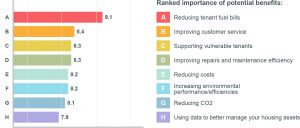
Following a recent smart heat survey of social landlords, Secure Meters’ Market Development Manager Nigel Ebdon makes sense of the feedback — assisted by Southern Housing Group’s Senior Home Energy Advisor Patryk Szczerba.
Of the many new sensor based smart home solutions currently available on the market, it appears that smart heat controls have caught the attention of social landlords.
Although other devices, including assisted living, home security and leak detection are sure to catch on eventually, it appears the potential financial and welfare benefits both for tenants and landlords are making smart heat controls an attractive proposition.
Secure Meters is a leading manufacturer of utility meters, with over four million UK domestic installations and 30 years’ experience working with UK social landlords. To coincide with the launch of Beanbag, Secure Meters’ first social housing smart heat control solution, we decided to commission a broad survey of social asset, sustainability and energy managers.
Potential benefits of smart heat controls
At a time when cost and efficiency savings are perceived to be an ever increasing priority for landlords, it was tenant support and welfare related benefits that come out on top in the survey, in particular reducing bills and tackling fuel poverty.
Patryk Szczerba commented: “I’m actually not surprised by this. Although it is the asset management value of smart heat controls that could potentially save landlords significant money over time, the most obvious upfront benefit is reducing tenant fuel bills.
“This is the starting point for many landlords: can the cost of heat be reduced without compromising the quality of warmth in the home? If the answer to this is yes, then it’s a massive tick in the box.”

Asset management benefits
Clearly, landlords value the ability to monitor humidity in homes. We have long been aware of the damage caused by subsequent mould growth, so much so that Secure Meter has partnered with the University of Southampton’s faculty of Engineering and Environment to better understand the problem.
Patryk continued: “Mould growth is often an expensive, perennial and ongoing problem for landlords. Firstly, there are health implications for tenants exposed to mould growth for prolonged periods of time — including nasal lung conditions, asthma and allergies in children.
“Removing and stopping mould growth isn’t always a simple process and often requires a combination of tradespeople and services to fix it. This can include the complaints team, housing managers, surveyors and contractors. In the meantime tenants may have to be rehoused. It all mounts up.
“Smart heat controls should be able to assist in a number of ways. Firstly, it can alert us to the homes with problematic levels of humidity, allowing us to take preventative action before mould growth takes hold.
“Secondly, it should provide my team with the information needed to have an informed conversation with the tenant. If we can see that humidity is spiking at say meal or shower times, we can suggest ventilating the bathroom or putting lids on pans.”
Barriers to adoption
The two main barriers to the adoption of smart heat controls identified are the upfront capital investment required to purchase and confusion over various technologies.
The issue of CapEx isn’t a surprise, and in my experience landlords would rather spread the cost by paying monthly for managed services — with guarantees that products will be maintained and kept up-to-date as part of any contracts. With solutions evolving so quickly you can understand why landlords are anxious to avoid purchasing ‘yesterday’s technology’.
Patryk said: “Smart heat controls should provide ongoing financial, environmental and social benefits — and this return should be balanced against upfront costs. However, keeping upfront capital costs as low as possible definitely makes purchasing easier, and most landlords now prefer to pay for new solutions as an ongoing service funded by the value they deliver.
“There are a lot of different connected home technologies out there from a growing number suppliers, and in an ideal world they would all be able to integrate and work together, but landlords understand that’s never going to be the case.”
Patryk concluded: “As well as conducting their own trials to test and compare various new technologies, landlords are also sharing pilot and installation data. This should prove reassuring to landlords and speed up mass adoption of the right solutions.”








